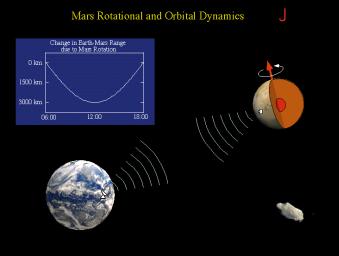
|
Mars Rotational and Orbital Dynamics
- Click the image above for a larger view
- Full-Res JPEG (731 x 553) (39.1 kB)
- Full-Res TIFF (731 x 553) (40.5 kB)
Caption:
The Rotation and Orbit Dynamics experiment is based on measuring the Doppler range to Pathfinder using the radio link. Mars rotation about its pole causes a signature in the data with a daily minimum when the lander is closest to the Earth. Changes in the daily signature reveal information about the planetary interior, through its effect on Mars' precession and nutation. The signature also is sensitive to variations in Mars' rotation rate as the mass of the atmosphere increases and decreases as the polar caps are formed in winter and evaporate in spring. Long term signatures in the range to the lander are caused by asteroids perturbing Mars' orbit. Analysis of these perturbations allows the determination of the masses of asteroids.
Background Info:
Mars Pathfinder is the second in NASA's Discovery program of low-cost spacecraft with highly focused science goals. The Jet Propulsion Laboratory, Pasadena, CA, developed and manages the Mars Pathfinder mission for NASA's Office of Space Science, Washington, D.C. JPL is a division of the California Institute of Technology (Caltech).
Photojournal note: Sojourner spent 83 days of a planned seven-day mission exploring the Martian terrain, acquiring images, and taking chemical, atmospheric and other measurements. The final data transmission received from Pathfinder was at 10:23 UTC on September 27, 1997. Although mission managers tried to restore full communications during the following five months, the successful mission was terminated on March 10, 1998.
Cataloging Keywords:
| Name | Value | Additional Values |
|---|---|---|
| Target | Mars | |
| System | ||
| Target Type | Planet | |
| Mission | Mars Pathfinder (MPF) | |
| Instrument Host | Goldstone Deep Space Communications Complex (GDSCC) | Mars Pathfinder Lander |
| Host Type | Ground-Based Observatory | Lander |
| Instrument | Goldstone Solar System Radar | |
| Detector | ||
| Extra Keywords | Asteroid, Atmosphere, Color, Radio, Rotation | |
| Acquisition Date | ||
| Release Date | 1997-10-14 | |
| Date in Caption | ||
| Image Credit | NASA/JPL | |
| Source | photojournal.jpl.nasa.gov/catalog/PIA00975 | |
| Identifier | PIA00975 | |
